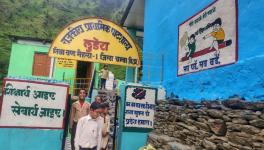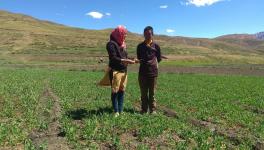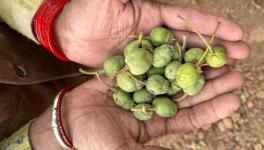Himachal, Uttarakhand Set to Make Fibers from Pine Needles That Cause Forest Fires
The season when forest fires ravage vast swathes of forests at the onset of summer will start in the Himalayan region next month. The forest department begins its preparation by constituting the fire fighting teams, repairing or purchasing necessary equipment and taking additional measures such as creating water trenches, checking dams etc., to tackle the forest fires.
Recently, the Himachal Pradesh forest department, for the first time, took the initiative on the utilisation of highly inflammable pine needles as a source of natural fibre in Sirmaur district of the state. Dehradun-based Forest Research Institute (FRI), which has developed the technology, will provide technical support to Himachal Pradesh (HP) in this regard. With this, HP has become the second Himalayan state after Uttarakhand in the country to adopt this technology.
Pinus Roxburghii Sarg (chir pine) is the most abundant tree species in the Himalayan region. The needles of the species largely contribute to the forest biomass and are a major cause of forest fires leading to climate change, biodiversity loss, etc. Moreover, pine forests occupy a considerable part of the central Himalayan region in North India.
Non-utilisation of the abundantly available forest biomass like chir pine is disadvantageous in multiple ways. Firstly, the raw material remains unutilised even though it may be a good bio-resource for valuable products. Secondly, it also leads to the destruction of forests by forest fires, thereby devastating the forest flora and fauna along with causing massive tangible and intangible harm to the ecosystem.
Further, the needles do not allow other important species to grow. Despite enormous harmful effects, the logical strategy on sustainable and effective management for utilisation of the needles is still being explored by scientists and experts.
Ajay Srivastava, head of forest force (HoFF) in HP, expressed hope for the future, saying, “The adoption of this technology will change the summer forest fire scenario in the state in the near future. Besides, a state where about 90% of the population is rural, this technology offers an option of income generation while using a resource that was so far considered a waste.”
In Himachal Pradesh, about 1,25,885 ha is estimated to be covered with chir pine forests. About 1.2 tons of pine needles are shed per hectare of pine forest annually, between April and June. These pine needles are very combustible and cause devastating forest fires during the summer season resulting in loss of timber, resin, plantations, wildlife, and other rare biodiversity worth crore of rupees.
Further, the Department incurs crores of rupees cost on forest fire preventive and control measures.
Sarita Kumari, the chief conservator at Nahan in HP, told NewsClick, “HP already has a policy on collection and removal of pine needles from the forest where local people get Rs 2 to 3 on the collection of per kilogram pine needles from the forest area. The cost for isolation of fibre is estimated to be approximately Rs 50-90 per kilogram, depending on the fineness of fibre. "
She said, “This small venture can be instrumental in diminishing the poverty of the underprivileged communities by enabling them to access the sustainably available and abundant bio-resource of pine needles, which has been an irritant for causing forest fires, reduced access to plenty of valuable species etc.” Besides, she said, the state government also provides investment subsidies up to 50% on pine needle-based industries.
The Chemistry and Bio-prospecting Division of FRI developed this novel process in their laboratory to isolate fibres from the pine needles. Dr Vineet Kumar, the chief scientist at FRI, said, “FRI has developed an easy, eco-friendly technique to extract fibres from pine needles. The technique does not require large space, energy, any instrumentation, etc. This makes it replicable on a large scale and can be easily taken up in remote areas having abundant pine needles as well."
The fibre obtained is aesthetic with cream-yellow colour, having a length up to 20 cm with reasonable bundle strength and good water absorption ability. It can be used for numerous purposes as per requirement. The isolated fibre can be spun into handloom cloth, and products like jackets, coats, purses, wall curtains, lampshades, mats, and ropes can be made. The rope net can be used in the mountains to bind large rocks and prevent them from falling.
FRI first shared this technology with Uttarakhand, which is in the process of establishing the system. HP has become the second state to embrace this technology.
Manoj Chandran, chief conservator of forest, told Newsclick, “As a chief executive officer of Uttarakhand Bamboo and Fibre Development Board, I carried out the experiment of making fibre out of pine needles following the technique FRI shared with the state forest department. We are all set to upscale it with affordable machinery and take it to different parts of the state, but the COVID-19 pandemic has delayed implementation of our plans for the time being.”
Uttarakhand has also been struggling with the pine needles menace. This state faces maximum forest fire incidents in the country. As per a report, out of the total forest area in the state, 16.36% (3,99,329 hectares) is covered by chir pine forests. Over 15 lakh metric tons of pine needles are generated annually in the reserve and van panchayat forests. Out of this, six lakh metric tons of needles are available for utilisation.
“The major issue is the collection of bulk chir pine needles, which can only be done in coordination with local people of several villages. Then comes the requirement of big storage spaces,” said Chandran. “Besides this, there is always the hazard of needles catching fire owing to their highly inflammable property, so we need to use it urgently. Then the economics of the cost of production, sustainability, transportation, and accessibility of markets for the produce are other challenges in the far-flung rural areas of the hill state."
As the state is still struggling to deal with the massive problem of chir pine needles, some experiments have been done, which have provided good results.
“In the state, some briquettes making units were set up, but the fact remains that coal costs cheaper than the briquettes, so buyers opt for the former. People who put in so much hard work in making briquette feel disappointed,” Chandran said.
There are some small energy plants which are using pine needles as a fuel source for biomass gasification, and the leftover carbon powder is utilised for making briquettes.
However, the usage of pine needles as a check dam to prevent soil erosion in various forest divisions of the state has worked quite well.
A check dam is a small dam constructed across a drainage ditch, swale, or channel to lower flow velocity. Reduced runoff velocity reduces erosion and gullying in the channel and allows sediments to settle out.
“Coir net bags made of natural material like coconut fibre are stuffed with pine needles. These are stacked in gullies wherever erosion takes place. The sediments get stuck in these bags while clean water flows out,” Chandran said. He added, “Pine needles were also used to treat landslide areas with the help of bamboo sticks and, in the conservation of degraded meadows at Dyara Bugyal in Uttarkashi and Panwali Kantha in Tehri Garhwal.”
The problem of soil erosion in high altitude alpine meadows in the Himalayas, which are blessed with unique medicinal and aromatic plants, was also treated by using geotextiles. Local people repaired some 600 metres of the Dayara Bugyal in Uttarkashi at the height of nearly 11,000 ft above sea level by using permeable textiles made of coir, bamboo pegs, and pine needles. The treatment helped augment soil stability, drainage, erosion control, and terrain protection in these alpine meadows.
The writer is a freelance journalist.
Get the latest reports & analysis with people's perspective on Protests, movements & deep analytical videos, discussions of the current affairs in your Telegram app. Subscribe to NewsClick's Telegram channel & get Real-Time updates on stories, as they get published on our website.
























